The WACU - the Water Corps Union of the Benelux countries – is the epitome of the turning point of the Dutch identity. As external support, the WACU forced the Netherlands to recognize that the Dutch position shifted from successful sea-level rise fighter to victims of climate change. A point in history that we – as Dutch historians – now describe as society-changing, and we – as descendants of Marshallese – should not be surprised about.
The WACU - the Water Corps Union of the Benelux countries – is the epitome of the turning point of the Dutch identity. As external support, the WACU forced the Netherlands to recognize that the Dutch position shifted from successful sea-level rise fighter to victims of climate change. A point in history that we – as Dutch historians – now describe as society-changing, and we – as descendants of Marshallese – should not be surprised about.
The WACU - the Water Corps Union of the Benelux countries – is the epitome of the turning point of the Dutch identity. As external support, the WACU forced the Netherlands to recognize that the Dutch position shifted from successful sea-level rise fighter to victims of climate change. A point in history that we – as Dutch historians – now describe as society-changing, and we – as descendants of Marshallese – should not be surprised about.
Sea-level rise and a sinking star
When the first parts of island states globally began to sink, the Dutch institution Deltares that used to sell tools and advise to countries for delta management was increasingly criticized for its cost-orientation and bureaucratic sluggishness. Its rebuilding programmes, launched to offer alternative housing to the displaced, got embroiled, leading to the first wave of emigration in that 253 Dutch families relocated to Luxembourg in 2052. As floods intensified and Dutch emigrants multiplied, Belgium and Luxembourg were faced with increasing visa demands. The generous support initially provided to Dutch families transformed into a lack of understanding. Why would Dutch communities be supported, when other Benelux countries were struggling themselves with environmental and economic crises? Social unrest peaked in 2057, when a groupuscule of Luxembourgish nationalists burnt a district inhabited by Dutch families in Bourscheid.
It became obvious to the Benelux Council that the difficulties of the Netherlands with sea-level rise were affecting internal concord in Benelux countries. This is how the Water Corps Union -today known as WACU - came to life. The WACU acknowledged the inability of the Netherlands to face sea-level rise without international support. It immediately launched a programme whereby young Benelux volunteers would build relocation districts in the Netherlands.
A burst of solidarity after the Mia: WACU support
When the Mia occurred in 2065, the WACU emerged as the only scheme able to provide immediate support to the 100,000 Dutch displaced. A wave of solidarity caught Benelux youngsters, and a record of 5,412 volunteers enrolled in the week following the Mia. Deltares’ response to the Mia emergency focused on urgent repairs and strengthening of coastal infrastructure. In this context, the Benelux WACU appeared as a refugees-oriented organization, whereas the Dutch
Deltares was perceived by most as the cause of weakened infrastructure.
Interestingly, the humanist WACU found many of its volunteers on Pacific-emigrant communities. Among the 5,412 volunteers, we estimate that a third were children of climate refugee parents, such as the son of the WACU architect
Carlon Zackhras. As Zackhras explained in 2066 to the Volkskrant, «the WACU showed that no power lasts forever. The threat of climate change that I denounced decades ago has finally affected communities who ignored mitigation responsibilities. The very existence of WACU shows that technology, money and influence are not sufficient to protect a country eternally. The WACU reminds us that international cooperation is needed by all, even by the wealthy Netherlands.»

Image: The first recruitment campaign for the WACU, based on Greater Green Bay Habitat for Humanity.
The Groot Trauma
While before the Mia flooding technological solutions have been helpful for the Netherlands to adapt to the rising sea level for nearly 900 years, the situation dramatically changed afterwards. The developed engineering solutions of pushing back and dominating nature were not sufficient, as they would simply not withstand the increasing natural forces. So, they were no longer able to fight the sea as they had been for many decades before. The fact that water could not be managed and hence, the country could not be protected anymore was a painful and disappointing realization, not only to planners and politicians, but also to all citizens that found pride in the Dutch water works. It was out of desperation that planners propelled to start searching for different solutions that would work with the inclusion of natural forces - not against them. Supported by the WACU experience, planners came to consider these nature-based climate adaptive solutions that had already been used for decades, for examples in the Marshall Islands. As a matter of fact, this is where the expression “to wacu a problem” comes from: after their failure with the flood Mia, the Netherlands eventually reconquered the water with floating houses, thanks to the WACU support. They accepted the uncertainty of a changing sea and built on it.

Curatorial Team

Freya Endrullis

Dominique Ernst

Maja Biemann

Rachel Lamothe
The Museum for the Future is a project created by the Urban Futures Studio
